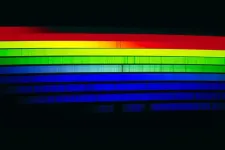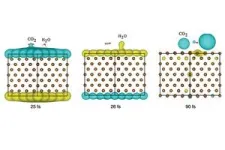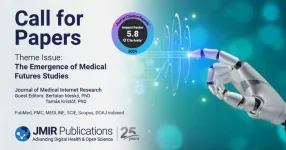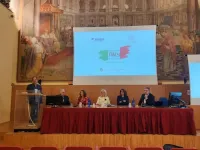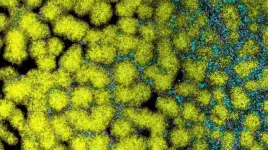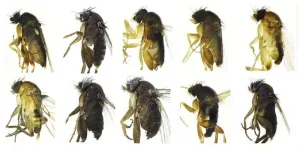(Press-News.org) CHAMPAIGN, Ill. — By combining visible light and electrochemistry, researchers have enhanced the conversion of carbon dioxide into valuable products and stumbled upon a surprising discovery. The team found that visible light significantly improved an important chemical attribute called selectivity, opening new avenues not only for CO2 conversion but also for many other chemical reactions used in catalysis research and chemical manufacturing.
One way that chemists recycle CO2 into valuable products is through a process called electrochemical reduction, where a stream of CO2 gas moves through an electrolysis cell that breaks the CO2 and water down into carbon monoxide and hydrogen, which then can be used to make new desired hydrocarbon products, said University of Illinois Urbana-Champaign chemistry professor Prashant Jain. “However, the reaction is sluggish, and the process requires large electrodes containing a lot of expensive catalyst material such as gold or copper, so our lab has been pursuing ways to speed up the process so that less catalyst material is required, making it a more viable option for the alternative fuels industry.”
The new study, led by Jain and former graduate student Francis Alcorn and published in the Proceedings of the National Academy of Sciences, details a method that combines the action of visible light with electrodes coated in nanoparticles of gold-copper alloy to induce CO2 reduction at a much higher rate and allow for more controlled selectivity than seen with current methods.
“These new electrodes act like tiny antennae that seek out photons in the visible light range and couple them with the chemical reaction pathway,” Jain said.
In the lab, the electrodes are immersed in a solution of CO2, water and an electrolyte to enhance conductivity. The team then applies a voltage across the electrode while a visible light laser illuminates its surface. The resulting reaction rapidly produces carbon monoxide — from splitting the CO2 — and hydrogen, which comes from splitting water molecules.
“We were very excited to see the boost in productivity when visible light was used. However, we were not expecting to find that using visible light would have a major impact on chemical selectivity, which is the important advance here,” Jain said.
In catalysis, chemical selectivity is the ability of a chemical reaction to favor or target one type of pathway or molecule over another. In this study, the researchers found that the water-splitting reaction that forms hydrogen gas was selectively enhanced by using light. This led the team to experiment further and model their results with the help of Northwestern University chemistry professor George Schatz and postdoctoral researcher Sajal Kumar Giri.
“The results revealed that visible light offers a unique opportunity to adjust the ratio of carbon monoxide to hydrogen gas produced, a crucial factor for the industrial production of synthetic gas,” Jain said. “This finding paves the way for a more sustainable and efficient energy future.”
Using light to help boost chemical reactions is not without its controversy, though, Jain said. Because adding light to a chemical reaction will also add heat, it was essential for the team to run careful measurements and control experiments to determine if it was simply the heating effect of light that led to faster reaction rates and selectivity.
“We ran experiments with and without the laser at the exact same temperature produced by light excitation and ruled out heating as being responsible,” Jain said. “Rather, electric fields and directed charge flow induced by light excitation were responsible for the enhanced productivity and increased selectivity of water splitting, which is captured in the simulations by our collaborators,” Jain said.
The team still has some challenges to face as they forge ahead. For instance, the repeated use of the nanoparticle-based electrode will inevitably lead to degradation over time, especially under a scaled-up scenario required for industrial application. Additionally, the overall energy efficiency of the process and light management will need further research and improvement.
“What we found with this study presents completely new ways of thinking about electrochemistry and catalysis,” Jain said. “By using light, we enhance the activity of this catalyst, but surprisingly, we also change the selectivity. This will open up new chemical pathways that make different products. And why stop at CO2 reduction or water splitting? This could be applied to many other catalytic reactions important to the chemical industry.”
Illinois Researchers Maya Chattoraj and Rachel Nixon also contributed to this study. The National Science Foundation, the U.S. Department of Energy, the Robert C. and Carolyn J. Springborn Endowment and the Future Interdisciplinary Research Explorations Grant supported this research.
Jain also is affiliated with the Materials Research Laboratory, physics, and the Illinois Quantum Information Science and Technology Center at Illinois.
Editor’s note:
To reach Prashant Jain, call 217-333-3417; email jain@illinois.edu.
The paper “Switching of electrochemical selectivity due to plasmonic field-induced dissociation” is available online. DOI: 10.1073/pnas.240443312.
END
The first randomized, placebo-controlled clinical trial evaluating the impact of therapeutic monoclonal antibodies on the risk of developing long COVID was led by researchers at Weill Cornell Medicine. The study, published Sept. 1 in eClinicalMedicine, details an international, multicenter phase 2/3 clinical trial that found a combination of amubarvimab and romlusevimab did not reduce the occurrence of long COVID symptoms.
Lasting weeks or even months after SARS-CoV-2 infection, long COVID is characterized by a variety of symptoms that affect each person differently. These include extreme fatigue, difficulty concentrating, ...
(Toronto, October 17, 2024) JMIR Publications invites submissions to a new theme issue titled “The Emergence of Medical Futures Studies” in the Journal of Medical Internet Research, the leading peer-reviewed journal for digital medicine and health and health care in the Internet age, indexed in PubMed, PMC, MEDLINE, SCIE, Scopus and DOAJ.
The rapid progress of technology in health care, combined with significant cultural shifts toward digital health and the urgent need for preparedness, highlighted by events such as the COVID-19 pandemic and climate change, have brought about an increased emphasis ...
Super-spy James Bond is a prime example of ‘regressive nostalgia’ highlighting how certain consumer groups cling to idealised past versions of brands and resist attempts to move with the times, a new study reveals.
Researchers examined the James Bond movie franchise - a cultural icon for over 70 years - and discovered that some ‘super-consumers’ react negatively to modern portrayals of the fictional British secret agent that reflect contemporary societal values.
Whilst loyal to the brand, these consumers prefer traditional, more exclusionary, versions of Bond which most closely follow author Ian Fleming’s original 1950s and 1960s vision – ...
A self-proclaimed Brazil-Italy collaboration enthusiast, researcher Laura Bolognesi created the B2AlzD2 Joint Lab at the Department of Pharmacy and Biotechnology of the Università di Bologna (UNIBO), the first Brazil-Bologna joint laboratory dedicated to the development of new drugs for the treatment of Alzheimer’s disease. The partners include scientists from four Brazilian universities: the Federal University of Rio de Janeiro (UFRJ), the University of Brasília (UnB), the University of São Paulo (USP Ribeirão Preto) and the Federal University of Minas Gerais (UFMG).
One of the laboratory’s ongoing ...
(Boston)—Researchers from the Center for Regenerative Medicine (CReM) at Boston University and Boston Medical Center (BMC) have announced a new collaboration with the global biopharma company GSK to advance innovative research focused on developing cutting-edge models to study and treat lung diseases like pulmonary fibrosis.
Pulmonary fibrosis, including its most common form, idiopathic pulmonary fibrosis (IPF), is a progressive and life-threatening condition that results in scarring of the lungs, making it increasingly difficult for patients to breathe. ...
Biofilms — slimy communities of bacteria — grow on all sorts of surfaces: from glaciers and hot springs to plant roots, your bathtub and fridge, wounds, and medical devices such as catheters. Most biofilms are composed of multiple bacterial species, but how these species manage to live together is unclear.
A new study by Dartmouth scientists in Current Biology uses experiments and modeling to delve into how three species of biofilm bacteria coexist — and when they move out on their own. One species, Pseudomonas aeruginosa, a verstaile pathogen known to be antibiotic resistant, dominated ...
COLUMBUS, Ohio – The microbes that cycle nutrients in the ocean don’t do the work on their own – the viruses that infect them also influence the process. It’s a vital job for the rest of the planet, enabling oceans to absorb half of the human-generated carbon in the atmosphere and produce half of the oxygen we breathe.
A new study gets scientists closer to more fully understanding where viruses fit into the global ocean picture of cycling nutrients such as nitrogen, phosphorous and, of particular interest, carbon. The research broadly expands on a 20-year-old finding that genes can be exchanged between viruses and the photosynthetic ...
WASHINGTON (Oct. 17, 2024) -- The U.S. Centers for Disease Control and Prevention (CDC) and the President’s Emergency Plan for AIDS Relief (PEPFAR), have awarded $27.5 million to the Center for Global Health Practice and Impact (CGHPI) at Georgetown University Medical Center to expand its ongoing work in Haiti to address HIV/AIDS.
For the 150,000 people in Haiti living with HIV, losing access to basic life-saving therapy can lead to unnecessary suffering, risk of transmission to others, and ...
The Earth is an almost unimaginably diverse planet in terms of species. Researchers have identified between two and three million species, but there are many more that we know nothing about.
The unknown species are called ‘biological dark matter’, borrowing a term from astrophysics.
“We want to demonstrate how we can gain a better overview of biological dark matter by using DNA barcoding,” said Associate Professor Emily Hartop.
DNA barcoding, in this case so-called ‘megabarcoding’, might sound mysterious, but it isn’t really. We will come back to that later. First, let us take a look at why ...
WASHINGTON — Americans believe volunteering to help strangers contributes more to society than providing care for family or friends, even though they contribute billions of dollars’ worth of labor in unpaid caregiving every year, according to research published by the American Psychological Association.
This perception could lead Americans of lower socioeconomic status to feel like they have less to contribute than people of higher socioeconomic status, because they often do not have the same amount of time or resources to devote to people outside of their communities.
“Over ...
